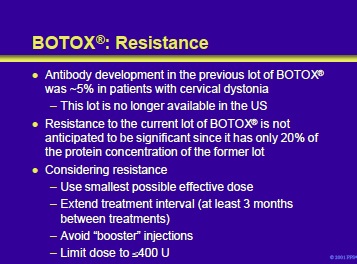
The BTX molecule is antigenic and has the potential to produce both neutralizing and nonneutralizing antibodies. However, the protein added to the vial to stabilize the preparation can act as an adjuvant; therefore, the total protein concentration is critical in determining the product’s potential immunogenicity. Furthermore, the total number of BTX units injected into the patient is another important factor determining the potential for antibody development.
The protein concentration in the current lots of BOTOX® is significantly less than the prior lot and, theoretically, should be less antigenic. It should be noted that antibody development has been primarily reported from studies on dystonia and not in patients with cerebral palsy and spasticity. In addition, caution should be exercised while interpreting this data since much of it is either retrospective or anecdotal.
It is the impression of the faculty that resistance due to antibody development is not a significant problem in treating children with cerebral palsy and spasticity. Instead, prior to attributing treatment failure to immunologic mechanisms, the treating physician should consider the possibilities that the wrong muscle was injected, the dose was incorrect, or the drug was inactivated by improper storage or handling.
When considering the possibility of resistance, the following precautions should be considered:
- Use the smallest possible dose
- Extend the interval between treatments as long as possible (³3 months)
- Avoid “booster” injections • Keep the Unit dose low (eg, £400 U)
Add comment